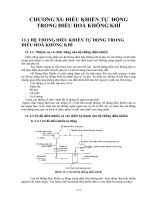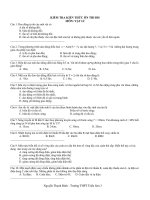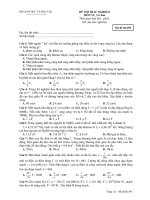PASSAGE 9
Bạn đang xem bản rút gọn của tài liệu. Xem và tải ngay bản đầy đủ của tài liệu tại đây (52.89 KB, 3 trang )
PASSAGE 9
History books recorded that the first film with sound was The Jazz Singer in 1927. But sound films, or
talkies, did not suddenly appear after years of silent screenings. From the earliest public performances in
1896, films were accompanied by music and sound effects. These were produced by a single pianist, a
small band, or a full-scale orchestra; large movie theatres could buy sound-effect machines. Research into
sound that was reproduced at exactly at the same time as the pictures - called "synchronized sound" –
began soon after the very first films were shown. With synchronized sound, characters on the movie
screen could sing and speak. As early as 1896, the newly invented gramophone, which played a large disc
carrying music and dialogue, was used as a sound system. The biggest disadvantage was that the sound
and pictures could become unsynchronized if, for example, the gramophone needle jumped or if the speed
of the projector changed. This system was only effective for a single song or dialogue sequence.
In the "sound-on-film" system, sound was recorded as a series of marks on celluloid which could be read
by an optical sensor. These signals would be placed on the film alongside the image, guaranteeing
synchronization. Short feature films were produced in this way as early as 1922. This system eventually
brought us "talking pictures".
Question 1. The passage is mainly about the ______________.
A. research into sound reproduction.
B. development of sound with movies.
C. disadvantages of synchronized sound.
D. history of silent movies.
Question 2. According to the passage, films using sound effects were screened ___________.
A. as early as 1922
B. in 1927
C. before 1896
D. as early as 1896
Question 3. The word "screenings" is closest in meaning to "________________".
A. projections
B. revelations
C. demonstrations
D. diversions
Question 4. Which of the following is not mentioned as a producer of sound to accompany movies?
A. a Jazz Singer
B. a single pianist
C. a gramophone
D. a small band
Question 5. It can be inferred that ______________.
A. sound-effect machines were not common because they were expensive
B. gramophones were developed about the same time as moving pictures.
C. most movie theaters had a pianist
D. orchestras couldn't synchronize sound with the pictures
Question 6. According to the passage, gramophones were ineffective because they _______________.
A. were newly invented and still had imperfections.
B. changed speeds when the needle jumped.
C. were too large for most movie theaters.
D. got out of synchronization with the picture.
Question 7. The word "sequence" is closest in meaning to _________________
A. distribution
B. organization
C. interpretation
D. progression
Question 8. The phrase "these signals" refers to ______________.
A. sounds
B. marks
C. series
D. sensors
Question 9. According to the passage, sound-on-film guaranteed synchronization because the recording
was ________.
Page 1
A. inserted beside the image on the film
B. marked on the gramophone
C. read by an optical sensor
D. made during the film of the picture
Question 10. Short feature films produced as early as 1922 __________.
A. were recorded by optical sensors
B. preceding talking pictures
C. were only effective for dialogue sequences
D. put musicians out of work
ĐÁP ÁN
1-B
2-D
3-A
4-A
5-B
6-A
7-D
8-B
9-A
10-B
LỜI GIẢI CHI TIẾT
Question 1:
-> B: bài đọc chủ yếu bàn về … A: nghiên cứu về sự phát âm lại; B: sự phát triển của âm thanh với phim
ảnh; C: nhược điểm của âm thanh được đồng bộ hóa; D: lịch sử của phim câmLoại A vì bài này khơng
bàn gì đến sự phát âm lại cả; C sai vì “synchronized sound” chỉ được bàn đến 1 chút ở giữa bài mà thôi;
D: bài đọc cũng không kể về lịch sử của phim câm -> B đúng
Question 2:
-> D: thông tin trong bài “From the earliest public performances in 1896, films were accompanied by
music and sound effects” -> đáp án D
Question 3:
-> A: screenings = projectors (n) màn hình chiếu/ máy chiếu
Question 4:
-> A: trong các đáp án sau, đáp án nào không được đề cập như là một nhà sản xuất âm thanh để hỗ trợ/ đi
kèm trong các bộ phim?Thông tin trong bài “History books recorded that the first film with sound was
The Jazz Singer in 1927 – sách lịch sử ghi lại rằng bộ phim đầu tiên có âm thanh là “ca sĩ nhạc jazz” vào
năm 1927 -> Jazz Singer là tên 1 bộ phim; ngoài ra trong bài cũng nhắc đến “From the earliest public
performances in 1896, films were accompanied by music and sound effects. These were produced by a
single pianist, a small band, or a full-scale orchestra; As early as 1896, the newly invented
gramophone, which played a large disc carrying music and dialogue, was used as a sound system.
->chọn A
Question 5:
-> B: có thể suy ra rằng …Thơng tin trong bài “Research into sound that was reproduced at exactly at
the same time as the pictures - called "synchronized sound" – began soon after the very first films were
shown. With synchronized sound, characters on the movie screen could sing and speak. As early as 1896,
the newly invented gramophone, which played a large disc carrying music and dialogue, was used as a
sound system” -> gramophone được sử dụng “as a sound system” mà “sound” được “researched” “at
exactly the same time as the pictures” -> đáp án B
Question 6:
-> A: theo bài đọc, gramophone khơng hiệu quả bởi vì chúng ….A: mới được phát minh và vẫn cịn nhiều
điểm chưa hồn thiện; B: thay đổi tốc độ khi kim nhảy; C: quá to đối với hầu hết các nhà hát; D: không
đồng bộ với hình ảnhThơng tin trong bài “As early as 1896, the newly invented gramophone, which
played a large disc carrying music and dialogue, was used as a sound system. The biggest disadvantage
Page 2
was that the sound and pictures could become unsynchronized if, for example, the gramophone needle
jumped or if the speed of the projector changed. This system was only effective for a single song or
dialogue sequence” -> như vậy Gramophone là 1 phát minh mới và cịn nhiều chỗ chưa hồn thiện ->
chọn A
Question 7:
->D: sequence = progression (n) chuỗi (hội thoại liên tiếp); A: sự phân phối (sản phẩm, hàng hóa); B: tổ
chức; C: sự giải thích; sự phiên dịch
Question 8:
-> B: câu trong bài “In the "sound-on-film" system, sound was recorded as a series of marks on
celluloid which could be read by an optical sensor. These signals would be placed on the film alongside
the image” -> như vậy: sound -> a series of marks -> placed on the film alongside the image” -> đáp án B
Question 9:
-> A: theo bài đọc, âm thanh trong phim đảm bảo được sự đồng bộ bởi vì việc ghi lại ….Thơng tin trong
bài “These signals (sound recorded) would be placed on the film alongside the image, guaranteeing
synchronization” -> chọn đáp án A
Question 10:
preceding talking pictures
Thông tin ở đoạn sau: “In the "sound-on-film" system, sound was recorded as a series of marks on
celluloid which could be read by an optical sensor. These signals would be placed on the film alongside
the image, guaranteeing synchronization. Short feature films were produced in this way as early as 1922.
This system eventually brought us "talking pictures".” (Trong hệ thống “âm thanh trong phim”, âm thanh
được ghi lại như một chuỗi các điểm trên chất celluloid mà được đọc bởi một cảm biến quang học. Những
dấu hiệu này sẽ được đặt vào phim dọc theo hình ảnh, đảm bảo sự đồng bộ hóa. Các thước phim ngắn
được sản xuất theo cách này vào khoảng năm 1922.)
Page 3









